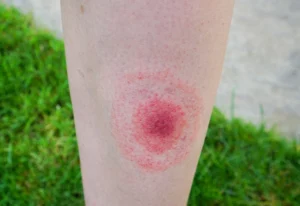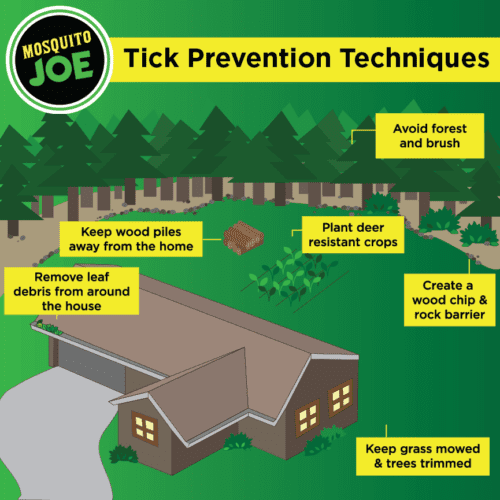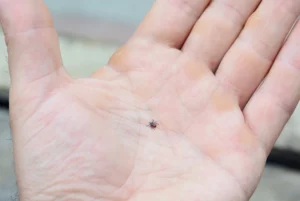As mounting evidence attests, ticks continue to evolve their ability to withstand cold temperatures, which now makes them a year-round problem. While this may tick off many outdoor enthusiasts who thought they could enjoy at least a few tick-free months, we have some advice that might ease your mind. . Instead of being ticked off, let’s explore how to keep ticks away and the best strategies to remove them if they do bite — any time of the year.

Tips and Strategies for Staying Tick-Free
Ticks are pretty simple creatures. Unfortunately, they dedicate most of their lives to hunting and feeding — and we’re on the menu!
Learning how to keep ticks away from you, your family and your pets comes down to a few simple approaches:
- Keep Away from Tick Country (when possible) – Wooded areas, mountains, foothills, and untended brush make for excellent tick habitats. You may also find ticks on the shores of lakes, ponds, or at the beach. If you do venture to these areas, see our ‘dress to avoid ticks’ suggestions below.
- Keep Ticks Away from Your Home and Property – Follow our tips for how to keep ticks away from your yard. Vigilance and consistency are two of the most important elements for success.
- Dress to Avoid Ticks – When you cannot avoid locations likely to harbor ticks, wear a hat or head covering, long sleeves, long pants, and socks, even when it’s warm. If the bottom of your pants is loose-fitting, tuck the bottom into your sock or use a rubber band to secure them. Bonus points for wearing light colors that make it easier to spot ticks that land on it. And use a spray-on tick repellent.
- Examine Yourself and Loved Ones – Ticks are persistent, determined creatures. Even if you take all the precautions mentioned, you must still examine yourself, family members, and pets when coming indoors from areas that may harbor ticks. You won’t feel a tick bite, so remain vigilant.
While most successful tick strategies that focus on how to combat ticks rely on avoiding the tick, it’s also important to understand what makes a tick, tick. let’s dig a little deeper into these critters.
Know Your Enemy: Understanding Ticks and Their Habits
When it comes down to how to combat ticks, it’s important to understand their needs and weaknesses. Ticks generally thrive in damp wooded areas where tall grass, shrubs, and trees grow unchecked. They are attracted to the edges where woods meet lawns, where untamed land meets residential development. Ticks hide in leaf litter, ground covering plants, and wood piles where small mammals live.
Ticks need a water source, and they thrive where humidity is high, and soil remains damp. They are highly susceptible to drying out. So tick control methods include cutting back on excess irrigation and any leaks on your property. Another strategy is to dust a fine layer of diatomaceous earth (DE) over common tick resting sites. For instance, dust pet bedding, dog houses, kennels, dog runs, and a dry “moat” around the perimeter of your property with DE.
Ticks will climb grass stems and shrubs to the height of their preferred hosts. Then, they reach out with their front legs, waiting to attach to a passing animal. This hunting behavior is called “questing.” Questing ticks hunt for hosts by seeking body heat, carbon dioxide, and the smell of lactic acid in human and animal sweat.
Protect Yourself and Your Pets: Tick Bite Prevention Strategies
Learning how to keep ticks away from your family and property so you can prevent tick bites involves understanding what ticks need.
- Recognize ticks’ hiding places. Ticks like to dwell in tall grass and wooded areas where the soil is moist or there is a water source. Gardening, hiking, and hanging out in your yard are all scenarios where you, your family, and your pets could attract ticks.
- Dress to avoid ticks. Long sleeves, long pants, a hat, and socks tucked into boots will help create a barrier between a hungry tick and your skin. It takes a while for a tiny tick to make its way past your clothing — hopefully long enough for you to spot it and remove it.
- Get professional barrier treatments from Mosquito Joe® for an added layer of defense. Regular tick control treatments will eliminate ticks and give some peace of mind to you and your family.
In addition to the tips above regarding how to keep ticks away from yourself and your property, paying attention to your pets is essential. Your pet’s health is critical. Also, pets can bring ticks indoors, where they can later bite you. So, protecting your pets from ticks should be kept in mind when considering tick control methods.
Your pet’s veterinarian can advise you on topical tick protection treatments to prevent ticks from biting. You can also explore how to keep ticks away from pets naturally.
While learning how to keep ticks off yourself and your family is critical, let’s be sure you know how to thoroughly search for any tick that may slip through your defenses.
How to Check for Ticks
Ticks can be as tiny as the tip of a pencil lead. They hide in warm places, making them difficult to find. Check these spots on yourself and your children when coming back indoors to ensure you don’t have any lingering ticks:
- Under the arms
- In and around ears
- Inside the belly button
- Back of the knees
- In and around the scalp and hair
- Between legs
- Around the waist
Inspect your pets for any ticks that could have latched on while outside. And examine your gear to avoid transporting a tick or two indoors. Additionally, throw clothes in the dryer for 10 minutes on high heat to remove ticks. Finally, promptly showering when coming indoors helps wash off unattached ticks and decrease the chance of contracting a tick-borne disease.
Tick Removal: Best Practices for Safe and Effective Removal
Ticks are wily opponents. Even the best tick control methods can be missed occasionally.. So it’s essential to know how to safely remove a tick if and when you or a pet are bitten.
The proper way to remove a tick is different from removing any other type of insect. While you can brush away most insects, a tick attaches to the body, bites the skin, inserts a barbed feeding tube, and begins drinking blood. This makes a tick unique from most biting bugs in that they remain attached to the body even after biting. Because ticks can carry and transmit diseases, knowing how to remove them properly and safely is essential. To get started, don’t panic! Just reach for a pair of fine-tipped tweezers to remove the small insect.
- Pull upward using steady, even pressure. Using this motion will ensure that the tick’s mouthparts don’t break off and stay embedded in the skin. If this happens, use the tweezers to remove the mouthparts.
- With soap and water or rubbing alcohol, clean your hands, the infected area, and the tweezers.
- Place the tick in alcohol, seal it in a container, wrap tape around it, or flush it down the toilet. Resist the temptation to crush it with your fingers, as this method could transmit disease.
- Following up: If you develop a rash, fever, or any other symptoms associated with tick-borne disease, seek medical assistance. Notify your doctor about your recent tick bite and when and where it occurred.
Removing a tick from a dog entails a similar process.
Tick-Bite Prevention for Outdoor Enthusiasts: Hiking, Camping, and More
Unfortunately, some of our favorite getaway locations, like hiking trails and campgrounds, are also highly attractive to ticks. So, let’s see how to keep ticks away when you’re adventuring in the great outdoors.
- Use tick repellant formulated for your skin, like DEET.
- Choose a campground that employs tick control methods.
- Set up your tent in a dry, sunny clearing.
- Clear away any piles of leaves, twigs, tall grass, or brush.
- Sit on camp chairs rather than on stumps or on the ground.
- Stick to well-tended paths, away from high grass and shrub brush.
- Buy firewood instead of collecting it.
- Place your worn clothes in a plastic bag and seal it.
- Treat your dogs before your trip.
- Check for ticks frequently, and pack your tweezers and alcohol.
Abide by the above tick control methods, and you can enjoy your camping, hiking, and fishing excursions to the fullest.
Tick-Borne Diseases: Recognizing Symptoms and Seeking Treatment

In the event that you or a loved one has been bitten by a tick, it’s critical to seek medical attention if:
- You are unable to remove the entire tick.
- The rash gets larger.
- You develop flu-like symptoms.
- The bite site appears infected.
- You think the tick was a deer tick. (In that case, you may need antibiotics.)
The above signs signal that you should consult your healthcare provider. However, seek emergency medical attention if any of the following occur:
- A severe headache
- Trouble breathing
- Paralysis
- A racing or pounding heart
Learning how to keep ticks away is essential to your health. And recognizing the signs that medical attention is required is just as important. Sharing this knowledge with your family, friends, and neighbors can help protect them as well.
Tick Awareness: Spreading the Word and Educating Others
The Mosquito Joe® entomologists and the rest of our team of pest control professionals work tirelessly to protect others from insects that present the danger of vector-borne disease and other problems associated with pests. A significant portion of our efforts is dedicated to educating our customers and the public about how to keep ticks away and stay protected from pests.
The Mosquito Joe blog is a consistent source of excellent information. Learn how to combat ticks and other pests that pose health risks and hamper your enjoyment of your outdoor spaces.
Protect Yourself and Your Loved Ones from Tick-Borne Diseases
Now that you’ve learned all about the tick control methods and strategies available to you, it’s time to call on the pros at Mosquito Joe to protect your home and property. Our regular tick-control services will eliminate ticks from your property, making it safe for family and pets to enjoy.
Mosquito Joe is a proud member of the Neighborly community of home service brands. This means all of our work is backed by the Neighborly Done Right Promise™ and our
Mosquito Joe® Satisfaction Guarantee.. So, you can rest assured the job will get done right the first time.
To rid your property of biting ticks, request a free quote today. Let’s make your outdoor spaces fun again!





